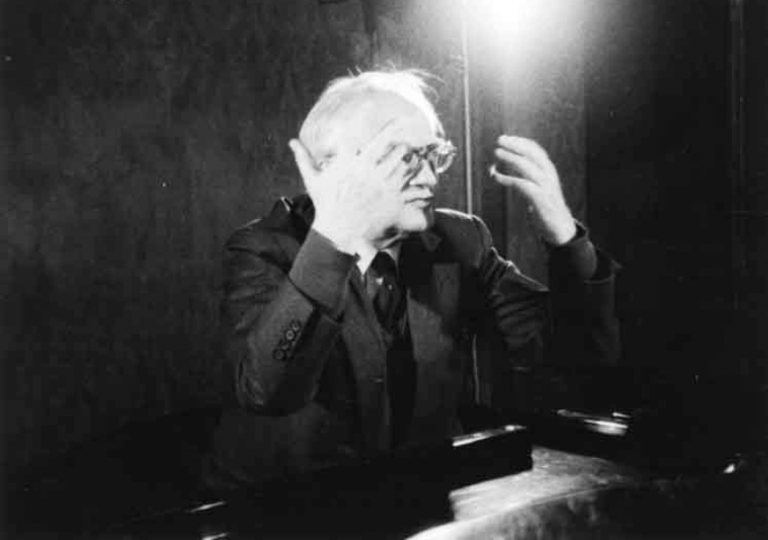Having been able to return at least to non-fiction directing in the 1970s, Drahomíra Vihanová became specialized in collective portraits of two or more characters and even work teams. In addition to these, she made several documentaries portraying prominent individuals, such as director František Vláčil, singer Eva Olmerová, and piano virtuoso František Rauch. She had an unusual bond with all of them. In the case of Rauch, their relationship was, without exaggeration, fateful.
After her studies at the Brno Conservatory and university studies of musicology, Vihanová left for Prague in the mid-1950s with the vision of fulfilling her childhood dream of becoming a pianist. She was to study piano at the Academy of Performing Arts under Rauch. However, after the graduation concert, he was adamant in discouraging her from applying to the Academy. Instead, she graduated from Film and TV School of Academy of Performing Arts (FAMU) and became a film-maker.
Nevertheless, she did not bear a grudge against the strict professor. First, she offered him a cameo in her student film The Black Keys Fugue (Fuga na černých klávesách), and then, in 1986, she dedicated a short film Variations on a Theme of Searching for Form (Variace na téma hledání tvaru) to him. In addition to her more than thirty-year acquaintance with Rauch, she took advantage of her understanding of musical forms. The formally complex document is composed as a three-part fugue.
For Vihanová, it was not just about recording a live concert and shooting Rauch’s portrait. Introduced with Čapek’s quote, “There is more restlessness than certainty in art,” the film also explores the (im)possibility of achieving perfection, whether in art or any other craft. According to Rauch himself, perfection is not even desirable. The piece of work would then be “inhumane and dead,” he claimed.
The document itself is restless. The fugue takes on the shape of three types of scenes. Rauch’s reflections, his preparations for the concert, and the performance of Beethoven’s Piano Concerto in E-flat major at the Municipal House in Prague. Each of the scenes moves forward along the horizontal axis, while on the vertical axis, their visual and sound aspects intertwine. The individual “voices” complement each other, react to each other.
Rauch’s words about stage fright, for example, are interspersed with a close-up of his hand as he prepares backstage. More footage of the preparations follows, while the monologue about stage fright continues. In the following shot we again see a close-up of hands, this time playing a part of the score. Music permeates the soundtrack as well. Similar overlaps and variations follow the footsteps of the gradating piece itself.
Right at the beginning, Rauch confides to the camera that he “doesn’t like to exaggerate” and that talking about himself in a way that would tempt him to fabricate is not his cup of tea. He uses gestures to emphasize his ideas. The stylistic analogy of this are the emphatic cuts from dialogue to short fragments of music. The virtuoso’s self-doubting words are then continually counterbalanced by longer shots of his sovereign performance where his mind and hands seem to be in perfect harmony.
The interconnection of the three visual and sound levels creates an abstract illustration of what Rauch says both during his interview with the director and when preparing for the concert. It is an audiovisual analogy of his ideas. When he speaks of the creative potential of interpretations and emphasises that the pianist must bring his own personality to the piece, a passage of the Concerto resounds, conveying what he means.
Just like in Searching (Hledání) about František Vláčil, there is yet another component of the polyphonic film: the capturing of the creative process. In addition to words and images, this time Vihanová also transferred it into an unorthodox composition of shots and into sound editing, where Rauch’s statements sometimes build on each other and sometimes there are dynamic jumps and sharp divisions and contrasts between them in an attempt to find adequate formal equivalents for his excited, restless talking and playing.
Ivan Vojnar’s camera is similarly restless. The occasionally out-of-focus image, the quick, jerky movements, and the transfocator track-ins on Rauch’s face and hands help to capture the pianist’s inner turmoil, his creative struggle with the score. The selected parts of Beethoven’s Piano Concerto, arranged in chronological order, represent another unifying line of the film.
Rauch’s unlavish performance of Beethoven’s last concerto, though, together with the fact that Vihanová is not interested in the applause of the audience or the sumptuous interior of the Municipal House, but only in the one man focused on his work, ultimately gives prominence to something other than eternal seeking and restlessness, namely the artist’s respect for the composition, and thus for his entire craft.
Variations on a Theme of Searching for Form (Variace na téma hledání tvaru, Czechoslovakia 1986), directed by: Drahomíra Vihanová, written by: Drahomíra Vihanová, camera: Ivan Vojnár, edited by: Drahomíra Vihanová. Krátký film Praha, 20 min.

